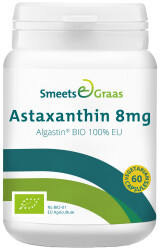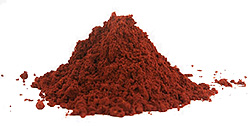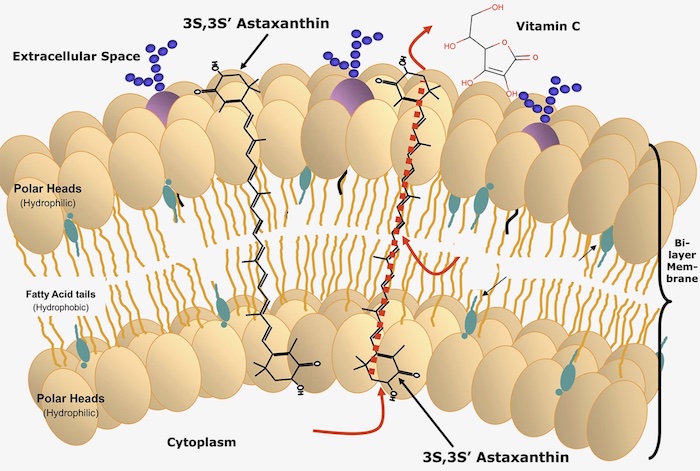19 Best Astaxanthin supplements

- 8 mg - high dose
- Contains Algastin® from the EU, Organic, without additives, in a base of Olive Oil

- Vegan - 6 mg - medium dose
- Contains BioAstin® from Cyanotech

- 4 mg - standard dose
- In a base of extra virgin olive oil for better absorption

- 4 mg - standard dose
- Contains BioAstin® from Cyanotech

- 4 mg - standard dose
- Contains AstaPure® from Algatech

- 4 mg - standard dose
- Contains AstaPure® from Algatech

- Formula for the eyes
- Contains astaxanthin, lutein, saffron, blackcurrant, marigold and carotenoids

- 5 mg - standard dosage
- Solgar astaxanthin

- 6 mg - medium dose
- Contains AstaReal® from AstaReal AB

- 8 mg - high dose
- Organic - vegan

- 4 mg - standard dose
- Contains BioAstin® from Cyanotech

- 4 mg - standard dose + selenium
- 100% certified organic

- 4 mg - standard dose
- 100% certified organic

- Combining astaxanthin and fucoxanthin
- Fucoxanthin derived from Wakame seawe

- 4 mg - standard dose
- With phospholipid mix for better absorption

- Astaxanthin with grape seed, green tea and resveratrol
- Rich in antioxidant nutrients

- Combination of astaxanthin, turmeric and black pepper
- 6 mg astaxanthin - BioAstin® van Cyanotech

- 4 mg - standard dose
- Contains AstaPure® from Algatech

- 4 mg - standard dose
- Contains AstaPure® from Algatech
Buy 100% natural Astaxanthin (4 mg, 6 mg, or 8 mg) on this page. Or find answers to all your questions about Astaxanthin below.
Which astaxanthin is the best?
 Please pay very close attention when buying astaxanthin: choose an astaxanthin supplement with a traceable and controlled natural extract. These are often patented or organic extracts. These are of much higher quality than other extracts, many of which are purchased from Asia for a very low price.
Please pay very close attention when buying astaxanthin: choose an astaxanthin supplement with a traceable and controlled natural extract. These are often patented or organic extracts. These are of much higher quality than other extracts, many of which are purchased from Asia for a very low price.
If you buy it at Kruidvat, Holland and Barrett (De Tuinen), Etos, anywhere else, even if you buy it from us, read the entire label to make sure it contains Algastin®, AstaPure®, AstaReal®, BioAstin® or an organic extract. Because the disadvantages of non-natural synthetic astaxanthin are too great and possibly even dangerous.
Is Astaxanthin Dangerous?
 The natural astaxanthin we sell is guaranteed safe. We only supply the patented Algastin®, AstaPure®, AstaReal®, BioAstin® and GSE and Solgar astaxanthin. These are high quality extracts of the microalgae Haematococcus pluvialis. This is the exact same astaxanthin that makes salmon, lobsters, shrimp and flamingos so beautifully pink.
The natural astaxanthin we sell is guaranteed safe. We only supply the patented Algastin®, AstaPure®, AstaReal®, BioAstin® and GSE and Solgar astaxanthin. These are high quality extracts of the microalgae Haematococcus pluvialis. This is the exact same astaxanthin that makes salmon, lobsters, shrimp and flamingos so beautifully pink.
65 clinical trials with Astaxanthin since 2007
With this natural astaxanthin, many scientific studies are being conducted. The results of these studies are positive and show that astaxanthin is completely safe even in doses much higher than 6 mg per day.
Avoid non-natural astaxanthin
Synthetic astaxanthin, on the other hand, can potentially be dangerous. Moreover, it is also a different substance, so it also has different properties. It is made from petroleum. Although it contains the same elements, its structure and therefore its action is different from astaxanthin as present in our food and supplements.
Does Astaxanthin Have Side Effects?
Astaxanthin has been used in dietary supplements for more than 23 years. Despite being used for so long, no side effects have been identified. It is among the very safest dietary supplements.
What does astaxanthin do?

Astaxanthin belongs to the family of carotenoids. These are fat-soluble colorful compounds found in many plants and animals. They have several functions in those organisms. One of them is protection against the harmful effects of sunlight.
Beta-carotene, lycopene and lutein can be located either inside the cell membrane or outside it, but not both at the same time. Astaxanthin, on the other hand, because of its molecular structure, occupies an optimal position in the lipid bilayer of cell membranes.
The Haematococcus pluvialis alga
The richest source of natural astaxanthin is the normally green alga Haematococcus pluvialis. When exposed to sunlight (UV), this alga produces the strong antioxidant astaxanthin and changes its color to bright red

Astaxanthin experiences
Because of European EFSA claim legislation, we are not allowed to say what astaxanthin is good for. However, we can say that it is among the most popular supplements, because people who try astaxanthin are so satisfied with it that they often continue to use it permanently. Moreover, there is a lot of research being done worldwide on the effects of astaxanthin. With very positive results.
There are unfortunately still many nonsense supplements that people use once and then never again, but astaxanthin is so valuable that even the pharmaceutical industry is already busy developing an astaxanthin-based substance.
It can also be used very well together with any other supplement you already use. Very effective is the combination with boswellia.
Use & Dosage
 The dosage used in studies varies between 4 mg and 40 mg per day. Of course, the dosage for optimal effect also depends on what it is used for. Generally, 4 mg is used as a maintenance dose, but higher doses may certainly be used when needed. If you want to know how much is best to use, chat with us or send us an email about it.
The dosage used in studies varies between 4 mg and 40 mg per day. Of course, the dosage for optimal effect also depends on what it is used for. Generally, 4 mg is used as a maintenance dose, but higher doses may certainly be used when needed. If you want to know how much is best to use, chat with us or send us an email about it.
How best to take it:
Astaxanthin can be taken at any time of the day. But do take it with a meal that contains enough fat. A meal with quite a bit of olive oil, for example, provides much better absorption than food with little fat or oil. This is because it is fat soluble.
Are children also allowed to use it?
It depends on the dosage. Supplements containing between 5.7 and 8 mg of astaxanthin are suitable for children 14 years of age and older. Supplements between 2.3 and 5.7 mg may be used by children 10 years and older. A daily dose of up to 2.3 mg is suitable for children aged 3 years and older.
Can it be taken together with medications?
There is no indication that it has interactions with medications.
People who buy Astaxanthin, also look at:
Which foods contain astaxanthin?
To get 6 mg of astaxanthin through diet, you would have to eat a large piece of "sockeye" salmon of the highest quality. Crab and shrimp are also a substantial source, but in those animals it is mainly in the shell. However, you would have to consume large quantities of crab and shrimp to get 6 mg.
Algamo Algastin®:

- Is certified organic
- Manufactured in the EU
- In a base of olive oil, which increases its absorbability
- Contains no excipients or fillers
- Patented and 100% natural
- The algae are grown in very pure spring water from the mountains
- Made in a closed bioreactor
- Is completely free of pollution and toxins
- Obtained by super critical CO2-extraction
- By solar energy
AstaPure®:

- Is patented and 100% natural
- Is made in a closed bioreactor
- Is completely free of contamination and toxins
- Is produced in the Arava desert
- Is obtained with supercritical CO2-extraction
- Makes use of solar energy
- Has been in existence for 22 years (since 1998)
- Is Halal and Kosher
Written by: Wouter Olthof
Reviewed by: Liesbeth Thoen
Updated: February 24, 2025
